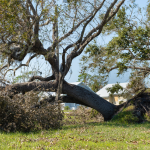How Can You Tell If Your Tree is in Trouble Before It’s Too Late? Insights from a Tree Care Company in Long Grove, Illinois
Trees don’t always show clear signs when something is wrong. Sometimes the warning signs are small and easy to miss unless you are really paying attention. Below, this tree care company in Long Grove, Illinois is going to explore some of the most common signs that your tree might need help from an arborist.
Discolored or thinning leaves
One of the first places you will see a problem is in the leaves. For example, if it is the middle of summer and your tree’s leaves are turning yellow or brown. You might also notice the canopy looking thinner than usual, like there is less shade and fewer leaves than there should be.
A healthy tree should look full and green during the growing season. You need to pay attention if yours looks bare in spots or uneven. These early changes are easy to miss, but if you catch them early, it could prevent bigger problems. This is one of those times when you must call a tree care company in Long Grove, Illinois to take a closer look at your tree.
Peeling or cracked bark
When the bark of your tree starts to peel or crack, that could mean the tree is infected with disease or rot. You might also notice soft or sunken spots. These are called cankers, and they can weaken the tree over time.
In some cases, big chunks of bark will fall off, exposing the bare wood under it. If you touch the trunk and it feels spongy or soft, especially near the base, your tree could already be in bad shape.
Mushrooms are sprouting near your tree
Mushrooms are not a good sign, at least not when they are sprouting from your tree’s trunk or roots. Fungi feed on dead or rotting wood, so their presence usually means that something inside the tree is rotting. Once a tree starts decaying from the inside, it can become dangerously hollow.
A few mushrooms around the tree’s base do not always indicate the worst, but it is worth getting your tree checked out by a tree care professional. They will know if the fungi are harmless or a sign of deeper problems.
Falling branches
Every tree drops a branch now and then. But if you see it happen more frequently, especially if the branches are large, it is time to take a closer look. Falling branches can be dangerous. But more than that, they usually point to deeper health problems.
Sometimes the branches die from the tips, and the damage spreads back toward the trunk. This is called “dieback,” and it usually means that the roots or lower part of the tree are at risk. You might not see it from the ground, which is why regular tree inspections are so useful.
A sudden lean
Some trees grow crooked from the start, and that’s okay. But what if your tree used to stand straight and has suddenly started leaning? That could be a problem. A new lean could mean that the roots are damaged, loose, or starting to rot.
This is the kind of situation that can turn serious fast. If your tree starts leaning and the ground around it feels soft or soggy, you should reach out to an experienced tree care company in Long Grove, Illinois ASAP. They can check if the tree is stable or at risk of falling.
Don’t ignore these common subtle signs
There are a few other signs that are easy to miss but still worth paying attention to. For example, if the trunk sounds hollow when you tap it, the inside might be rotting. Or if you see insects burrowing into the bark, they could be feeding on weak wood or carrying diseases with them.
Even things that look harmless, like unusual growth patterns, can be a red flag. For example, a tree with multiple trunks growing out of one spot could split more easily in a storm.
Looking for a Tree Care Company in Long Grove, Illinois?
If you think that something is wrong with your tree, you should trust that feeling. It is always better to check with an arborist than to wait until it is too late. If you are looking for a professional tree care company in Long Grove, Illinois that can inspect your tree, our team at Brown Tree Service, Inc. is just a call away. Contact us today to schedule an inspection.




